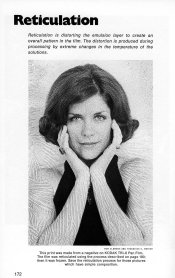Photo Engineer
Subscriber
"Process as carefully as you would color film". This is apparently a quote of John Sexton reproduced here by Ian Grant.
I would like to note here that color films are generally softer than B&W films due to their thickness and due to the coupler content which tends to lower hardening effects. Therefore, they should be more subject to reticulation effects than B&W films.
Here then is a problem. Kodak says that although the developer must be at 100F or 37.8C, the bleach (or stop) immediately afterwards can be as low as 75F or 24C. This is an allowable 25 degree F shift with no reticulation of any sort. Can anyone explain this? Both B&W and color films use the same hardener and use it at about the same level based as a percent / wt of gelatin coated. No problem here.
Now, if we go back to Mark's micrographs, we see that grain is randomly distributed but there has been no motion.
As for Kodak studies of lateral and vertical movement of grains, yes, there is a lot of work on this starting with Ross (among others) who proved that there are no lateral movements beyond about 2 microns, and the only vertical movement is due to the expansion and contraction of gelatin in a vertical manner due to processing, but the silver grains are all retained in place relative to each other.
There are no articles. If Grant has suddenly found any when his library is reported to be in the UK, he must have a library with him, or he took a sudden trip to England in spite of the weather there!
No, I'm afraid that the preponderance of evidence is against clumping and micro reticulation. However, lets name this unknown the "Grant Effect". It is a fugitive, unproven sudden increase in grain caused by an unknown effect. No examples have been shown that have been verified as being this effect, but it has been claimed to exist for at least 30? years. All reports have come from magazines or circular internet reports quoting each other!
PE
I would like to note here that color films are generally softer than B&W films due to their thickness and due to the coupler content which tends to lower hardening effects. Therefore, they should be more subject to reticulation effects than B&W films.
Here then is a problem. Kodak says that although the developer must be at 100F or 37.8C, the bleach (or stop) immediately afterwards can be as low as 75F or 24C. This is an allowable 25 degree F shift with no reticulation of any sort. Can anyone explain this? Both B&W and color films use the same hardener and use it at about the same level based as a percent / wt of gelatin coated. No problem here.
Now, if we go back to Mark's micrographs, we see that grain is randomly distributed but there has been no motion.
As for Kodak studies of lateral and vertical movement of grains, yes, there is a lot of work on this starting with Ross (among others) who proved that there are no lateral movements beyond about 2 microns, and the only vertical movement is due to the expansion and contraction of gelatin in a vertical manner due to processing, but the silver grains are all retained in place relative to each other.
There are no articles. If Grant has suddenly found any when his library is reported to be in the UK, he must have a library with him, or he took a sudden trip to England in spite of the weather there!

No, I'm afraid that the preponderance of evidence is against clumping and micro reticulation. However, lets name this unknown the "Grant Effect". It is a fugitive, unproven sudden increase in grain caused by an unknown effect. No examples have been shown that have been verified as being this effect, but it has been claimed to exist for at least 30? years. All reports have come from magazines or circular internet reports quoting each other!
PE













